Do you want to learn HOW TO START A BLOG, but don’t know where to start? Look no further, we’ll walk you through it step-by-step.
Want to just get started? Click here to sign up for Bluehost and start your blog website today.
Creating a blog is an excellent way to share your passion with the world. Blogging is one kind of income stream that helps you to make money online and live life like a boss.
But how do you start a blog related to your interest and be successful?
Don’t worry, we’ll show you how. This guide will go over how to start a blog in 2024 in easy steps.
Let’s get started!
Top-Rated Web Hosting Companies For Make Money Blogging
If you’re looking to start a blog that brings in some cash, you’ll need a reliable web hosting company to get started. Check out these top picks:
- Bluehost: Perfect for those new to WordPress
- Hostinger: Great for affordable long-term plans
- Cloudways: Offers affordable options with room to grow
- A2 Hosting: Provides speedy shared hosting
- Nexcess: Excellent for managed WordPress hosting
- InMotion: Best for those with technical know-how
Each of these companies has its own strengths, whether it’s affordability, user-friendliness, or top-notch customer support. Consider your needs and preferences when making your choice.
Either way, you can read our full reviews of each web hosting company here.
How To Start A Blog in 2024 – Step-By-Step Guide

Starting a blog in 2024 isn’t as scary or overwhelming a task anymore! But, the truth is, blogging allows you to experience the financial freedom of the life you want to live.
However, If you’re looking for a simple step-by-step guide on how to start a blog from scratch, follow the 7 easy steps below:
- Select a profitable blog niche
- Choose a blogging platform
- Pick a great domain name
- Get a good blog hosting
- Build your blog with Bluehost & WordPress
- How to promote your blog
- Start making money through blogging
I guarantee, that after following this guide, you will have your own professional blog that is ready to share your thoughts with the world.
Let’s get started.
Step 1: Select a Profitable Blog Niche
If you want followers, traffic, or money fast, selecting a niche plays an important role, whether it is for business or others.
Obviously, blogging is business, and a business needs a niche to play. But most newbies are confused, about what to blog be about and switching from one niche to another.
Do you know why?
99% of bloggers quit blogging in a few months because they choose the wrong niche. And 1% succeeded, because of the right niche selection.
So, select one niche that you have an interest in. There are many bloggers or internet marketers out there, they grab one niche, and become the leader of that niche.
Want to be a leader of a Niche? Hell, YES, who doesn’t want that?
So, What Exactly is A Niche?
A niche is a specific or focused topic, which is…
- smaller,
- specific,
- known to you,
…and a blog niche is the focus or main topic, you want to write all your content.
For example; my blog niche is “Blogging”. But you might notice, that I write about, SEO, Online income, Marketing, Web Hosting, SAAS tools many more. Because all topics I cover are related to ‘Blogging’.
On the other hand, a niche is understood to be a particular industry, like dentists, freelancers, and accountants.
Why Do You Need A Blog Niche?
Without a niche, you’re in the ocean with no direction. But, almost every successful blog you have seen or run all they have a niche. That is why you need a blog niche.
Another point is you need a niche because the niche gives your blog focus and helps it find the right audience.
There are plenty of niches available to start with, only you need to pick your suitable niche. Whether it’s fashion, travelling, sports, e-commerce etc.
Tips For Selecting A Blog Niche
You can find a big list of niches, but here is the core fact you should consider while selecting a niche.
#1. Your Interest First
Your interest first! if you have no interest in a topic to write a blog about, you can’t go far.
A couple of months later you have a high chance to lose interest in it and quit blogging. Because you cannot force yourself to stick with blogging if you don’t like the topic.
However, starting a blog is a really fun learning process. It can either be a hobby or your work.
You don’t need to be an expert on this topic but gets you excited when talking about it. Your interest ensures that you are really passionate about the topic you picked.
#2. Pick A Smaller Niche
A niche can be anything, but make sure it is small. Here is an example:
- Broad Niche: Photography
- Micro Niche (more specific): Wedding Photography
Generally, the more micro or specific you get with your niche, the more genuine and passionate your followers will be.
Always try to avoid competing with big authority websites. You would better pick a smaller niche to become the authority.
So, pick a small niche because it focuses on a more specific keyword, that can be more profitable in today’s view of blogging.
#3. Demand & Competition
Before you start a blog in 2024, make sure you measure the demand and competition is important to select a blog niche.
Many new bloggers make mistakes like before knowing how to swim, just jumping in the ocean.
Same as, before doing the proper market research, just start blogging and shift from one category to another.
That’s not going to work.
You need to do research. To do accurate research you need to use SEO tools like SEMrush, Long Tail Pro, and Ahrefs.
You can use any of them, but in my case, I use SEMrush personally. This is one of my most favourite blogging tools for figuring out a market or niche, and it is much better than any of the other SEO tools, in terms of long-tail keyword research.
For example, let’s say the ‘bonsai tree’ is your niche.
For this, I use the SEMrush keyword magic tool, search the seed word, and select the country.
Once, I search, I will get tons of ideas like search traffic, and competition. For more details, you can check how to do keywords with the SEMrush keyword magic tool.
#4. Make Sure Your Niche is Profitable
You can pick whatever topic, you want. But make sure it’s profitable because your time has value. So, select a niche, that you can monetize your blog in the future.
Are you planning on earning money from blogging? If yes, you should remember that your niche is profitable enough to earn a good income.
Once you find the right niche for your blog, the next step is to find the best blogging platform, to host or make your blog live on the internet.
Step 2: Choose A Blogging Platform
Choosing a blogging platform is the next crucial part, of starting a blog in 2024 from scratch.
Here are some popular blogging platforms to consider;
There can be many more but WordPress (self-hosted) is the one software that comes with everything, you need to create and grow your business blog.
That’s why whenever someone asks me where to start a professional blog site, I highly recommend building your blog with WordPress.
Why WordPress?
WordPress powers over 45% of websites on the web. Also, there are tons of good reasons you will find on the internet.
Here are a few reasons to choose WordPress for blogging in 2024:
- Offers complete ownership (full control)
- 100% free open-source software
- Lets you create any type of website
- Easy to use with unlimited customization possibilities
- Seo-friendly (easy to rank your on SERPs)
Additionally, there are plenty of more reasons, why I use WordPress for my blog, and similarly, 45% of the world’s websites or blogs are built with it.
And, always prefer to go with WordPress (self-hosted) which costs you little money for:
- domain name registration,
- and web hosting services.
With just a little money, you can take charge of how your website looks and works using WordPress. It offers loads of plugins and themes that make your blog stand out, even if you’re not tech-savvy.
Step 3: Pick A Great Domain Name
The next step in the blog setup guide is domain selection.
Before you start a blog, selecting the right domain name with the right domain provider is one of the most important or major things you’ll do for your Blog.
A domain name or blog name is a reflection of your activity and it is more than just a web address.
So, What’s Exactly A Domain?
A domain name (or just a domain) is the unique and specific address of your website or blog.
For example, aioshortcodes.com is our overall online identity.
I have started AIO Shortcodes as a WordPress plugin – a free WordPress plugin that lets you add dynamic content inside your blog website using way shortcodes.
Previously, when I started my first blog in February 2016, named missingideas.blogspot.in. It was published on Blogger.com – a free blogging platform by Google.
And, once I got the ability to invest money in 2019, I purchased my dream domain wpblogging101.com. Since then WP Blogging 101 has been the main blog to make money online.
Here, I personally recommend you buy the premium domain. Obviously, it will cost you a little extra. But, when you register your domain name at Namecheap (the #1 cheapest domain registrar in the industry), it will cost you just $0.99 or even less.
Also, changing the domain name isn’t a good idea at all, but sometimes we often do. But I don’t recommend making the same mistakes as I did.
Tips For Picking A Great Domain Name
Picking a domain is not a very overwhelming or tough task to do while you build your blog. But, the right domain name matters a lot in terms of a long-term blogging vision or brand.
If you’ve already decided on your dream domain name to create a blog, you can skip this part. OR if, haven’t selected your dream domain yet, here are some tips that help you find a great blog domain;
- Choose a .com: Pick a .com domain instead of co.UK, .org, .biz, and so on.
- Easy To Remember: Make sure your domain name is short or easy to remember.
- One or Two words: One word is perfect, if not two are also perfect. For example, One word: Amazon.com, Google.com, and Two words: ProBlogger.com, SmartBlogger.com, CopyBlogger.com, or Harpreetkumar.com.
- Easy To Type: Make your domain name easy to spell, reduce the length, or if possible use memorable words.
- Avoid Numbers: Stop thinking of using numbers in your domain name because numbers are always hard to remember.
- Use Keywords: Using keywords in your domain name gives you an extra boost in SEO.
- Your Feels: Make sure your feeling about your name is matched.
Your user or readers will first notice your blog name, instead of other things.
So make it recognizable, easy to remember, and a proud representation of you and your brand.
Step 4: Get A Good Blog Hosting
Blogging has great potential as a career and requires room to expand. Since it’s a thriving online business, reliable web hosting is essential to keep your blog accessible and operational.
So, What Exactly is Web Hosting?
Web hosting is a place where all your files or data like images, posts, pages, and many more are stored. And, when choosing a WordPress hosting service for your blog, it’s essential to pick a reliable provider.
Since there are tons of blog hosting companies out there, Bluehost stands out as a top choice.
They offer reliable hosting services for both new and existing blogs, making them a great option for starting or migrating your blog.
So instead of giving a big hosting list, I strongly recommend you go with Bluehost.
Why Choose Bluehost Hosting?
Personally, I have used Bluehost for so long and recently hosted another new blog with Bluehost. Actually, I’ve got nothing but good things to say about it.
Bluehost is probably one of the most reliable and cheapest (less than $3 per month) hosting providers out there.
As compared to other providers domain names also come at a handy price but with Bluehost, you can get that for FREE first year.
It has hosted over 2 million domains and is one of the most popular & reliable web hosting in the industry. It offers:
- 1-click WordPress installation,
- a 99.9% uptime guarantee,
- and smart 24/7 support.
It’s a smart choice for every website owner and we rate them 5 out of 5 stars.
👉 Sign up for Bluehost today and enjoy up to 75% INSTANT discount on shared & WordPress hosting plans.
Pick Your Hosting Plan – Easy Steps
If you’ve already purchased hosting, you can skip this part. OR if you haven’t still bought yet, then follow the guide below.
Step #1: Go to Bluehost.com

First, visit bluehost.com to begin the process.
Step #2: Choose A Web Hosting Plan
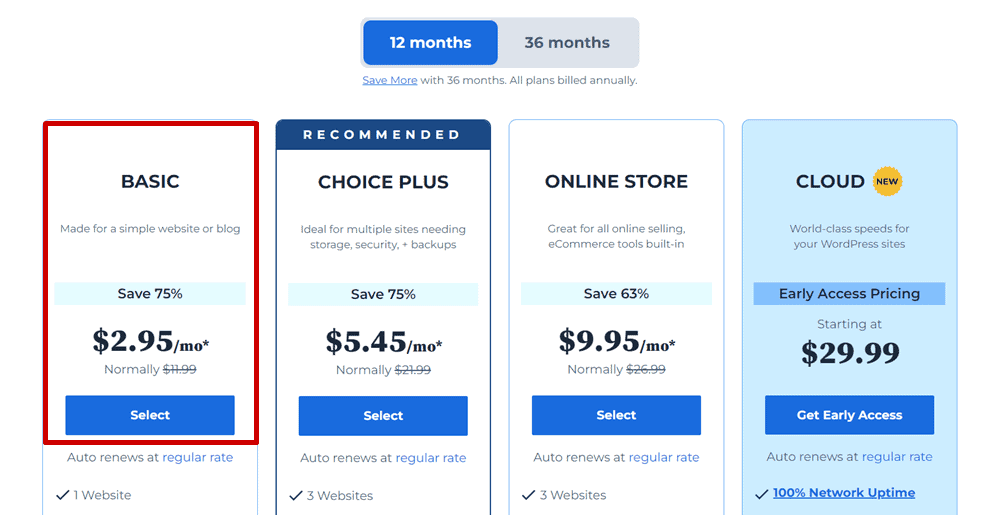
Once you’re on the homepage, select a hosting plan that suits your needs. There are four options:
- Basic,
- Choice Plus,
- Online Store,
- and Cloud.
If you’re just starting with one website or a personal blog, Basic is okay. For more features and flexibility to run multiple sites, go for Choice Plus.
I recommend Choice Plus for new websites because there are many features you need just a few months later.
Note: Skip the Bluehost Online Store offer popup as we are starting a blog on WordPress using Bluehost hosting.
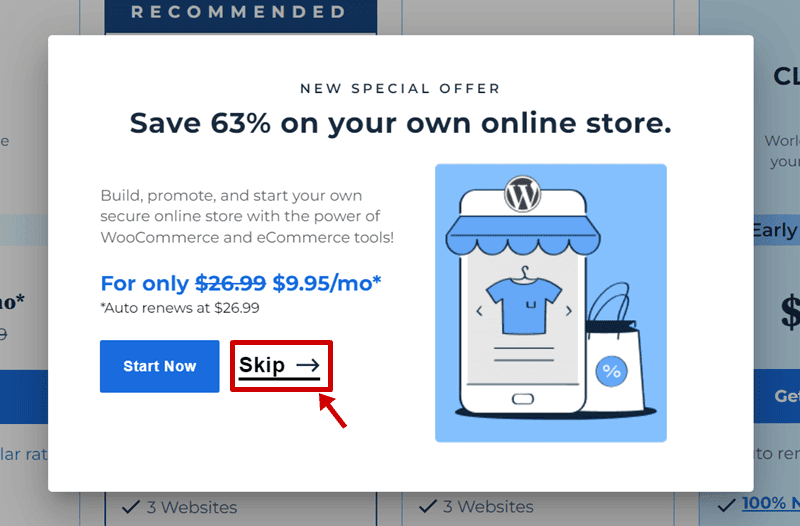
Step #3: Choose Your Domain Name
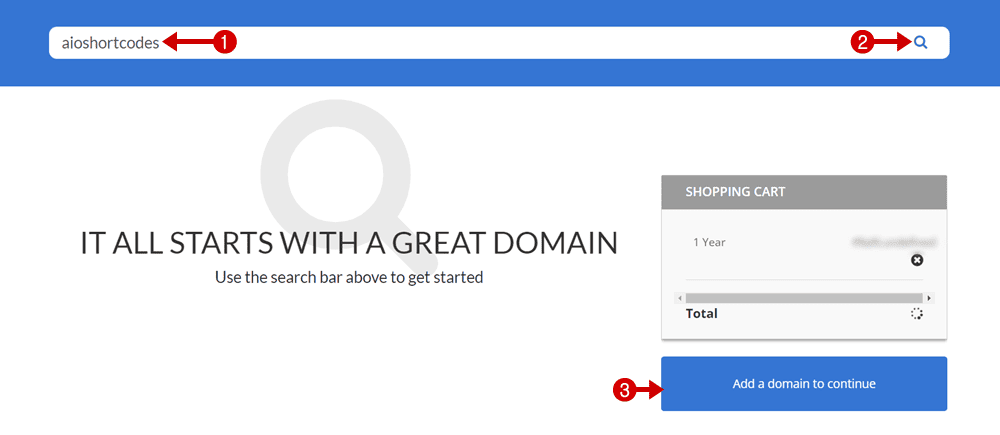
After selecting a hosting plan, you’ll be asked to choose a domain name. You can either buy a new domain or use an existing one. Bluehost offers a free domain for one year. But if you prefer, you can get one from NameCheap for more flexibility in the future.

I recommended you buy a domain name from a different company. Why? Later on, if you want to move to a new hosting provider, for any reason, then you don’t have to worry about your domain name.
Step #4: Enter Your Personal Information
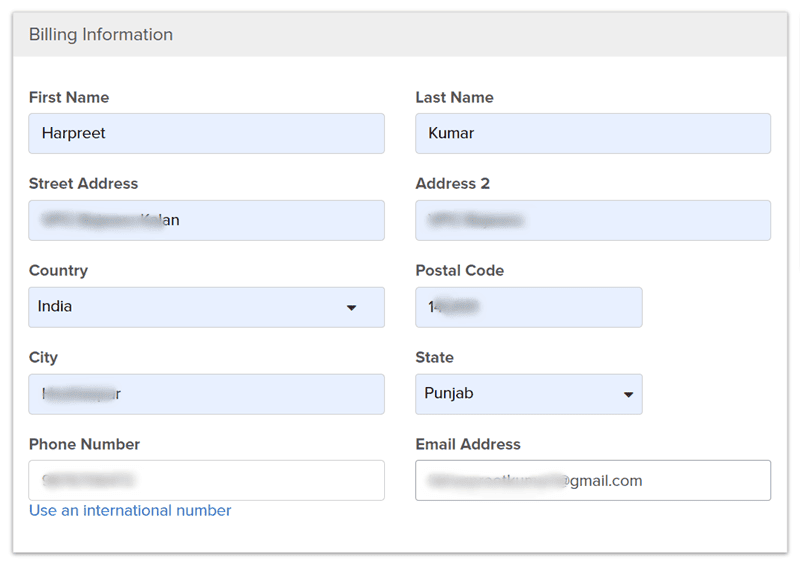
Fill in your details such as name, address, phone number, and email to complete the registration. Make sure to use valid information as this will be your contact info.
Step #5: Select Optional Add-Ons
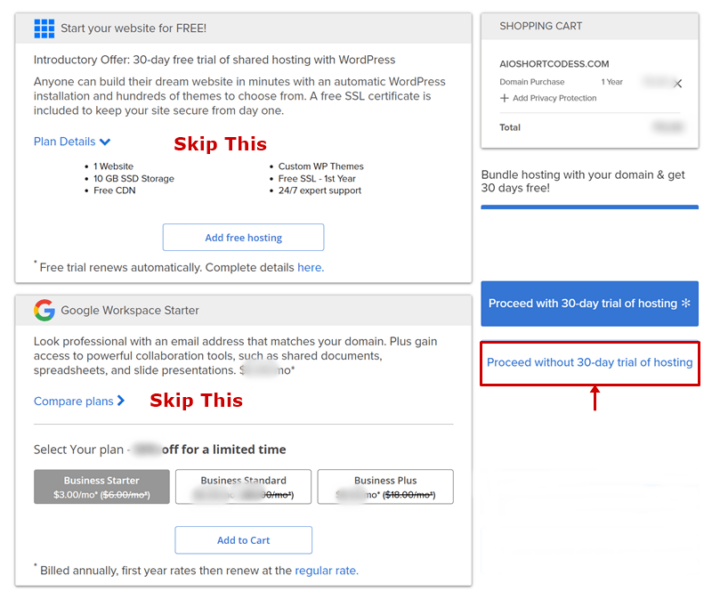
Basically, by default, Bluehost adds your package for 36/m. But it’s up to you how long you want to stay with Bluehost. I mean, 12/m, 24/m, or more. So, Select the plan duration you wish to buy.
There are also a few add-ons selected by default but you could uncheck them like Codeguard Basic, Sitelock, and more if you don’t want them. The add-ons provided by Bluehost are great, but mostly they aren’t required. So, you can uncheck them.
Here is the deal; if you buy through our special discount link you will get 75% OFF as I mentioned earlier. You don’t need to apply an extra coupon code, it’s automatically will be applied.
Now review the order before you finally check out.
Step #6: Finish Registration

Once you’ve selected everything you need, proceed to payment. Choose your payment method, agree to Bluehost’s terms, and click “Purchase Now“.
Congratulations! You’ve successfully set up your hosting service account with Bluehost. Now you’re ready to build your website.
-> For more details, check out my article on, how to buy web hosting from Bluehost website.
“Consider opting for a WordPress hosting provider such as:
- Hostinger,
- Nexcess,
- A2 Hosting,
- or Cloudways,
…when exploring alternatives to your current hosting company.
Utilizing a WordPress blogging platform streamlines the setup process significantly. For additional insights, refer to our curated list of top WordPress hosting providers.“
Step 5: Build Your Blog With Bluehost & WordPress
I hope you already bought web hosting from Bluehost. If you still have not bought yet, Claim our 75% OFF coupon, which saves your pocket.
#1 Step: Installing WordPress On Bluehost
Bluehost offers a simple cPanel (control panel) dashboard, making it easy to install WordPress. This is why I recommend Bluehost for starting a WordPress blog from scratch.
To begin the WordPress installation process, log in to your Bluehost account using the username and password you recently created.
You can also check the email you received after making the purchase for login details.
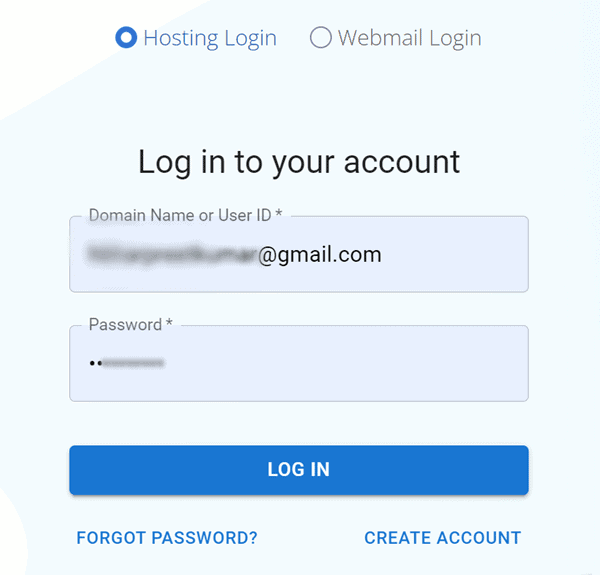
Click on the My Sites option.
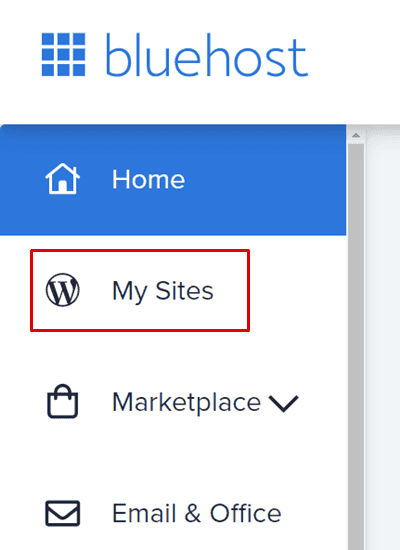
Inside the My Sites section, tap on the Create Site button.

Enter your Site Name and Tagline. Then, go to the Advanced Tab where you can set your WordPress Dashboard email/username and password. After filling them out, click the “Next” button.
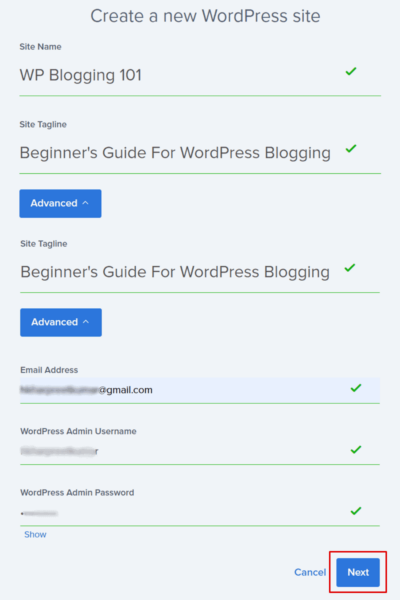
In the next window, your domain name will be selected. Before proceeding, uncheck all plugins: WPForms, OptinMonster, and MonsterInsights.

Select your site type: Blog and hit Next.
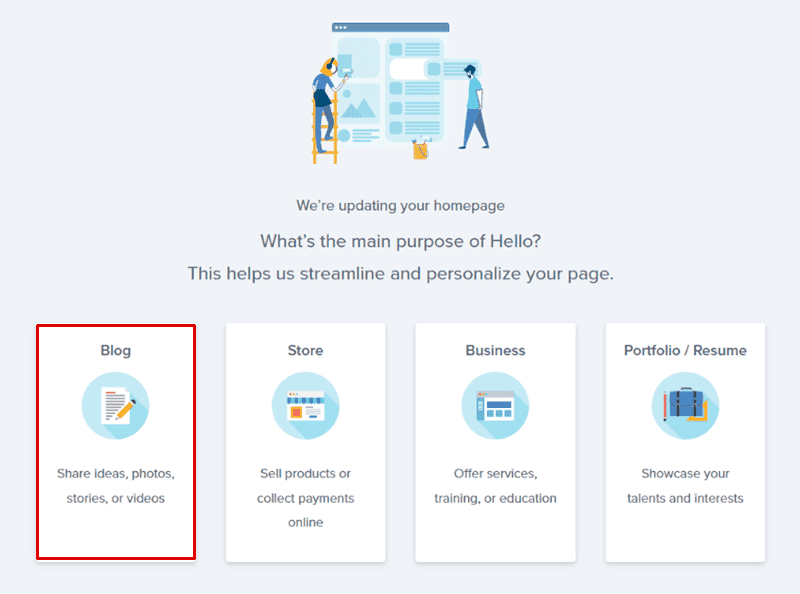
Shortly, WordPress CMS will be successfully installed on your server, and you’ll get an email containing the WordPress login link.
Click on that link to access your WordPress Dashboard, or go to yourdomain.com/wp-admin (replace “yourdomain.com” with your domain name) to sign in directly.
#2 Step: Exploring WordPress Dashboard Navigation
When you log in to your WordPress dashboard, you’ll have access to a range of essential tools and features including:
- Updates
- Posts
- Media
- Pages
- Comments
- Appearance
- Plugins
- Users
- Tools
- Settings
Additionally, depending on the plugins you install (we are going to discuss later below), you may find additional menu options tailored to their specific functionalities and how they’re coded.
Let’s deeper dive into the WordPress Dashboard options.
1. Updates
Updates are a regular part of the WordPress experience, with frequent releases aimed at resolving minor bugs and enhancing the platform’s capabilities.
Within the update section, you’ll find options to update plugins and themes manually. Additionally, you can also update plugins directly from the plugins or themes pages for added convenience.
2. Posts
The “Posts” menu helps you handle your blog content by letting you add new posts or delete old ones.
- All Posts: This page shows a list of all your blog posts. From here, you can edit posts and change categories, tags, and authors. Clicking on a post allows you to view or edit its content.
- Add New: Takes you to a page where you can create a new blog post.
- Categories: Helps organize your posts into specific categories.
- Tags: Similar to categories, but for adding descriptive tags to your posts.
Additionally, you can define this section to manage your blog content control.
3. Media
The Media menu section allows you to upload various files like images, videos, and audio to your blog.
- Library: View and edit all the media files you’ve uploaded.
- Add New: Quickly upload new media to your blog.
You can manage your uploaded files, add them to posts, pages, or other parts of your site, and edit their details in the media section.
4. Pages
Pages are sections of your blog that don’t need frequent updates, like “About Us” or “Contact Us“.
- All Pages: Similar to “All Posts“, it allows you to quickly manage all your pages.
- Add New: Let you create a new page.
The page is not like blog posts, It’s timeless static content that doesn’t have a publish date or update regularly.
But Posts have a publish date and update on time, which shows up on a blog page that lists all your blog posts in reverse chronological order.
5. Comments
The “Comments” menu helps you manage messages or feedback left by visitors on your site, which can appear on both pages and blog posts.
You can review comments and choose to approve, disapprove, or delete them as needed.
6. Appearance
The Appearance menu has a lot more items for changing the blog design.
- Themes: With this, you can either install new themes or delete the installed themes.
- Customize: You can customize your blogs, like your site’s title and tagline, colour, background image, and many more.
- Widgets: It is a box for special codes if you want to add to various places on your site. Whether, it is like your homepage, header/footer, or sidebar.
- Menus: This is the list of links to pages/posts on your site; that will be added to a header and footer menu.
- Header: Basically it will provide options for customizing your header menus like uploading a logo or background color.
- Theme Editor: It plays a sound role when you want to add extra CSS, HTML, JavaScript, and PHP. You can change or build anything if you know anything about coding.
Note: You can take more advantage if you install certain themes and plugins.
7. Plugins
Plugins are like add-ons for your website that can alter its appearance and functionality.
- Installed Plugins: Lists all the plugins you’ve added to your site.
- Add New: Lets you search for and install new plugins.
- Plugin Editor: Allows advanced users with coding skills to directly edit plugin code.
Plugins enhance your website’s capabilities, taking its functionality to the next level.
8. Users
The “Users” menu allows you to manage accounts for individuals who work on your site.
- All Users: Displays the number of user accounts on your blog.
- Add New: Let you create a new user account.
- Your Profile: Where you can update your account details like email, password, and profile picture
Note: Once you add each new user you have to add the role of the particular user.
9. Tools
The “Tools” menu offers functions for managing specific tasks on your site.
- Available Tools: Lists tools provided by certain plugins.
- Import: Allows you to bring data from other websites into WordPress.
- Export: Lets you export content to be imported into another WordPress site.
- Site Health: Provides insights, tips, and stats to optimize your blog’s performance.
- Export Personal Data: Export any personal information stored on your site.
- Erase Personal Data: Removes personal information of users with accounts on your blog.
WordPress comes with these default options, but additional tools (with customizable functions) can be added with plugin installations.
10. Settings
This is the last and most important thing in your WordPress blog. The “Settings” menu holds most of the general settings options for your WordPress blog.
The “Settings” menu allows you to configure various aspects of your website:
- General: Basic settings like date format, timezone, site name, and URL.
- Writing: Default categories and post format settings.
- Reading: Choose between a static homepage or displaying your latest blog posts, and set the number of posts per page.
- Discussion: Control how comments function on your site.
- Media: Adjust default image sizes for uploads.
- Permalinks: Customize the structure of your blog URLs.
Note: Once you install Plugins in the settings will add more options, along with the defaults including:
#3 Step: Installing A WordPress Theme
In this section, you’ll learn how to effortlessly install WordPress themes to customize the look and feel of your website.
First, let’s understand the basic idea of a WordPress theme.
What is a WordPress theme? And how to install it on your blog?
A WordPress theme is like a ready-made design for your blog. Changing your theme can quickly improve how your site looks and feels.
Today, having a good design is crucial for blogging. It helps make a positive impression on your audience and builds trust with your readers.
To change your theme, go to your main dashboard and click on “Appearance” then “Themes“.
There are two ways to add a theme:
- You can install a free one from WordPress or upload a premium one you’ve bought elsewhere.
- If you’re adding a free theme, just search for it using the search bar, click “Install“, and then “Activate Theme“.
If you have a premium theme, you’ll need to upload the ZIP file and then activate the theme. That’s it!
See! Changing your theme isn’t so hard, right?
Here are some of my favourite themes that personally use and recommend when it comes to starting a blog from scratch in 2024.
While some themes are available for free, I always suggest investing in premium themes for your blog. Even if you’re on a tight budget initially, it’s worth paying for a premium blog theme.
1. Kadence WP
If you want to start a blog in 2024, then the Kadence Theme(AIO Shortcodes uses Kadence Pro) is the most popular and powerful theme you can use on your blog site.
With Kadence, you can quickly and easily build incredible WordPress website designs, whether you’re a novice or an advanced developer.
The best part of the Kadence theme is that it is search engine optimization and the fastest theme as well.
GeneratePress is another WordPress blog theme that comes both free and paid, choices which version you want to use.
It is also a fast and beginner-friendly theme that is easy to customize so anyone newbie or advanced can customize it.
3. Avada Theme
Avada is also one of my favorite blog themes ever used starting a blog all the time. I have used it, since 2018 and it is the most powerful theme that has ever been built.
Avada is the best-selling theme on ThemeForest. It has all the necessary options like premade-design templates, email opt-in, shortcodes, and many more.
The theme is 100% fully responsive and easy to customize. If you want to start an affiliate marketing website blog, this theme is like a golden piece for you.
However, many more features in Avada help you to make your website more powerful within a few seconds.
4. Hestia Pro
Hestia theme comes both free and premium and it is a lightweight and easy-to-customize blog theme.
You can use either the free version or the paid version, whichever depends on your blog goals. But remember, they have a lot of features that aren’t available in the free version.
However, with the Hestia Pro theme, you can make your homepage attractive and responsive too, by installing the Elementor page builder.
Still, if you don’t figure out, which theme you need to use on your new blog, then check my list of the 12 best paid themes for new blog.
#4 Step: Adding Plugins To Your WordPress Blog
I hope you’ve got your dream theme installed, it’s time to add plugins to enhance your blog’s functionality.
Next up, to install plugins; head to the “Plugins” section in the main menu and then click on the “Add New“. This will take you to the plugin page.
Here, you can search for desired plugins using the search bar or upload a paid plugin that you’ve purchased from a marketplace like Codecanyon.
Essential (Must-have) Plugins For Your Blog
As part of this beginner-friendly tutorial, let’s focus on installing essential plugins to kickstart your blog’s functional journey.
There are over 100,00 plugins available, both free and paid. While you can choose any plugin you want, I’ll recommend some essential ones to get you started with your new blog.
- AIO Shortcodes (Free): Adds dynamic elements to your site with easy-to-use WordPress shortcodes.
- Rank Math (Free + Paid): Boosts your site’s SEO with tools like on-page analysis and keyword tracking.
- WP Rocket (Paid): Speeds up your site by caching pages and optimizing performance.
- ShortPixel (Free + Paid): Optimizes images for faster loading times.
- Solid Security (Free + Paid): Protects your site from security threats like malware and unauthorized access.
- Solid Backups (Free + Paid): Safely backs up your site and restores it if needed.
- MonsterInsights (Free + Paid): Tracks your site’s traffic and provides easy-to-understand analytics.
Here are some Gutenberg plugins for blog posts and page styles (use only one at a single time):
- Kadence Blocks (Free + Paid): Offers customizable blocks for easy content design within the WordPress block editor.
- GenerateBlocks (Free + Paid): Provides lightweight blocks for creating layout elements like grids and buttons efficiently.
- Ultimate Blocks (Free + Paid): Add extra blocks to the WordPress editor for creating engaging content.
- Thrive Architect (Paid): A visual page builder for creating custom layouts with conversion optimization in mind.
- Divi Builder (Paid): A popular drag-and-drop page builder for creating custom designs and layouts easily.
That’s all some of my recommended plugins you can use on your WordPress blog.
Important Note: Never use cracked or GPL themes from unofficial sources. They might have harmful code that can damage your website. Stick to downloading plugins and themes only from official stores to keep your site safe.
#5 Step: Start Writing Your First Blog Post
Now, you might wonder about;
- how to write my first blog post,
- or what my first blog post be about?
Wait! What is the blog post anyway?
Blog posts consist of a title or headline, body content (which includes all the words and images in the post), and meta information such as the author’s name and publishing date.
In short, blog posts are what WordPress was built for. For example;
- how-to guides
- top 10 tips
I hope you got my point! Now it’s time to make some posts for your new blog.
Login to the dashboard and click on Posts > Add New. It will open a new post page where you can write the blog post.
The post/page layout can be defaulted or changed depending on the WordPress theme, you are using currently.
However, there is all you can do…
- Add title
- Post
- Block
- Status & Visibility
- Permalink
- Categories
- Tags
- Featured image
- Excerpt
- Discussion
- Meta Tag
Now, all you need to do is write whatever you want and click ‘Publish’—and you’re all set!
And that’s it.
In this section, there’s no need for EXTRA to teach you anything. Instead, you can become the master and teach others as you continue to learn.
Firstly, congratulations from the bottom of my heart! And, welcome to the world of blogging!
You’ve successfully set up your WordPress blog. But since you’re still reading, it shows your passion for building your blog successfully in 2024.
If you’re ready to take your blog to the next level, here are some pro tips to help you grow your blog and make passive income from blogging.
Step 6: How To Promote Your Blog
Blog promotions play an important role in the very beginning of blogging.
Because at the beginning time, we don’t have so much traffic that can bring leads or sales. So, your blogging purpose will only be fulfilled once you start getting traffic on your blog.
If you expect traffic from Google, typically it takes a few months, depending on how frequently you publish and update your blog posts. Alternatively, there are a couple of ways you can promote your blog, some are free and others paid.
But, as you just started I only recommend the easy freeway. Here I will share some tips on how to promote your blog and get a targeted audience.
1. Pinterest
Pinterest is counted as a traffic hub, where you can easily get tons of traffic sharing your blog image. I like Pinterest so much because I drive some targeted traffic on my blog that brings revenue.
So, create your Pinterest account today, and start to generate traffic on your blog. We are also active on Pinterest (@passiveblogger), make sure to check our pin.
2. Social Accounts
Social media is one of the old and valuable concepts to bring traffic to your blog. These are really very powerful tools to promote your content.
Every time you post a new article on your blog and share it on your social media account, you will find some magic in it. But be sure active on social media to engage your readers.
3. Videos Platform
YouTube is a big deal because lots of people use it. So, it can be a FREE traffic source to drive traffic to your blog in very little time.
If you want more people to see your blog, you can make a video and put it on YouTube. Alternatively, you can make use of Facebook and Instagram video tools to earn some referral traffic to your blog site.
4. Networking
The more people you engage, the more you can earn. It’s quite like, impacting millions of people, and making millions.
So, networking is one of the best ways to promote your content. There are many bloggers and influencers, who build a network around the niche.
Join our Free Blogging Community by WP Blogging 101, where experts share the latest updates and strategies. You’re welcome to be part of our community group too.
5. Q&A Forums
Question and answer forums are another free platform to drive traffic to your blog. There are some popular Q&A Forums like Quora and Reddit that work best at the beginning of blogging.
All you need to do is create an account and give the answers in your niche, in the meantime direct them to your blog. This is the way Q&A Forums actually work.
I hope, by now, you have some ideas to bring traffic to your blog. But what do you do once you start getting traffic? Don’t worry, there is one step more to succeed in blogging.
In the next step, I will give some ideas on how to monetize your blog and make money blogging.
Step 7: Make Money Blogging Online
Making money blogging is quite dependent on the type of niche you’ve chosen or the monetization model you use on your blog.
Let’s dive into the four popular monetization methods and explore how to optimize them for maximum earnings.
- Affiliate Marketing
- Ebooks
- Advertising
- Selling Freelance Services
These are the 4 primary methods, that you can use to make money from your blog.
Let’s dive into detail.
1. Affiliate Marketing
Affiliate marketing is one of the best ways to make money through blogging. It is also one of the best ways to make a passive income from blogging and I love it.
The affiliate marketing involves promoting products on your blog, and you earn a commission for each sale generated through your referral.
The more you sell products, the more you get commissions from the product brands. One of the core benefits of affiliate marketing is that you don’t need to hold any inventory.
If you want to start a blog in 2024 and make money through blogging, affiliate marketing leads to success in blogging.
Popular affiliate platforms like Amazon Associates, ShareASale, and cj.com offer lucrative opportunities for bloggers to earn money by joining their affiliate programs and promoting products.
2. eBooks or Information Products
Creating eBooks and Information Products can be a lucrative opportunity for bloggers to monetize their content in 2024.
While it may require initial effort, once you start gaining traffic and generating income, your audience will trust you more, making them more likely to purchase your eBooks or courses.
These products offer a passive income stream as you can sell them repeatedly with minimal additional effort.
By building a loyal audience through consistently providing value, you can turn your fans into paying customers and accelerate your path to achieving your goals.
3. Advertising
When it comes to monetizing your blog through advertising, Google AdSense is often the go-to for many new bloggers.
However, advertising opportunities extend beyond AdSense, with brands offering sponsor posts that can earn you anywhere from $50 to $250 per post.
While sponsor posts typically require a significant amount of organic traffic, AdSense remains a trusted and effective option for monetization.
Here’s a simplified breakdown:
Google AdSense:
- Well-known and reliable option.
- Easy to get started, but requires at least 15-20 quality posts for approval.
- Offers a good amount of earning potential, especially in niche markets.
Sponsor Posts:
- Opportunities from brands for sponsored content.
- Can earn $50 to $250 per post.
- Typically, it requires higher organic traffic levels.
Advertising continues to be a popular method for monetizing blogs, especially in lucrative niches where substantial earnings are possible.
Starting a blog in 2024 and earning through Google AdSense is absolutely achievable. Just ensure you have 15-20 high-quality posts before applying for approval.
Additionally, advertising remains a popular choice for monetization, especially in profitable niches where substantial earnings are possible.
4. Selling Freelance Services
Selling freelance services is another way to make money from blogging. In the beginning, it can be a lucrative way to offer your service to others. But it can be time-consuming too.
Want to make money through blogging? Selling freelance services is a great way to start.
Here’s how:
- Offer services like content writing or copywriting. Many people are making good money this way.
- Whether you’re a photographer, writer, or have any other skill, you can sell it online.
- By reaching a global audience digitally, you increase your chances of finding clients.
So, if you still haven’t started a blog yet, you’re losing your value that could be profitable if you want to sell your skill.
You know what, blogging can REALLY change your life if you choose your blog niche wisely to ensure profitability.
The other, thing I suggest you improve your content for SEO and blog marketing skills, the money will come your way.
FAQs On Creating A Successful Blog Website
Here are some of the frequently asked questions, we bring together for more clarity on how to start a blog from scratch.
Should I start a blog in 2024?
Blogging is the ultimate road to financial freedom. If you want to start your own online business in 2024, blogging can be the ultimate choice.
This is the only business that you can start for under $100, which also gives you freedom in life. It also leads you to experience some adventure in life, learn new things or express new things, and make money too.
Is starting a blog in 2024 still worth It?
Yes, starting a blog is still worth it in 2024. Blogging comes across in a new version if you take blogging as a business.
Blogging is not just a hobby anymore but it’s a lot more than that because many people make good money from blogging. So without worry, you can set up your own blog today.
Can I start a blog for free in 2024?
Yes, of course! You can start a blog for free with a free platform like Blogger or Medium.
But I never ever recommend starting a blog for free. Instead, I suggest, spending some money to start a self-hosted blog. Of course, it costs you money but to be honest with you it is very much worth it.
How much does it cost to start a blog in 2024?
The total cost of starting a blog depends on your blogging goals and the type of blog you want to create.
In general, creating a blog is cheap in 2024, and it will just cost you even less than $100 for:
shared web hosting e.g. Bluehost
premium WordPress theme e.g. Kadence WP
Essential WordPress plugins e.g. Rank Math, WP Rocket & AIO Shortcodes (100% FREE)
How to start a blog and get paid?
This article is all about, how to start a blog in 2024 from scratch, and here I’ve mentioned all needy tips to make money from blogging. Just follow the word, I have mentioned.
Do I need to learn coding before starting a blog?
Absolutely not! You don’t need to learn coding to create your blog. Since WordPress was born, building a website has been easier than ever. With WordPress, you can easily build your blog without having knowledge of coding.
What do I need to build a blog with WordPress?
Basically, you need only two things; first a domain name, and 2nd a reliable web hosting service. With two of these, you can build your blog with WordPress how you want to.
Final Thoughts On How To Create A Blog & Make Money Blogging
Congratulations! You successfully created your very first blog in 2024 from scratch. Now you have your own domain name, hosting space, and blog that is fully ready to share your thoughts with the world.
Also, I’ve mentioned some of the pro tips to grow your blog traffic and make money, it’s just the beginning but there are a lot more things you need to do.
I know you have the burning desire to make money blogging in 2024, hope you do it right away.
Lastly, if you want to be a successful blogger, you have to follow what others do. Following others doesn’t mean copying them, once you follow them, you get your mistake and a new way to grow your blog.
Still not using AIO Shortcodes?
Install our plugin to boost your site’s content SEO, automate your affiliate marketing, and lots more, just by using these simple WordPress shortcodes.

